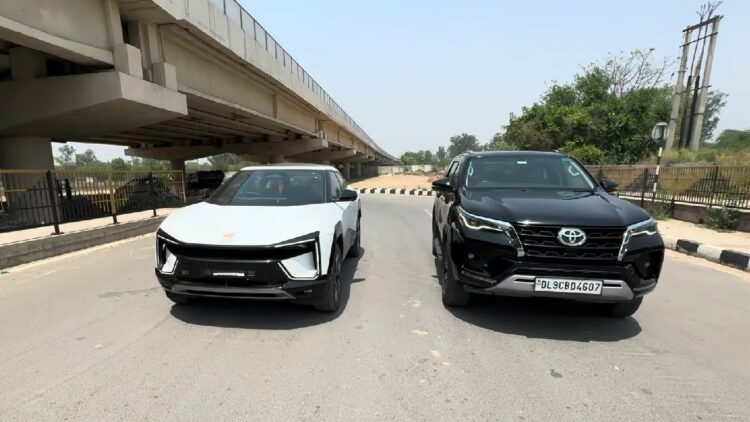YouTubers often conduct drag race competitions to compare the straight-line performances of two vehicles
In this post, we compare the Mahindra BE 6 and Toyota Fortuner in a classic drag race event. This is a rivalry between the diesel mill and an electric powertrain. Clearly, the two can’t be further apart in terms of application. The diesel SUV is used as a passenger carrier and for off-roading. In fact, Fortuner is the most successful 7-seat off-roading machine in the country. On the other hand, the BE 6 represents the best that Mahindra has to offer in the EV space. For now, let us compare the two on the basis of straight-line acceleration.
Mahindra BE 6 vs Toyota Fortuner Drag Race
We get the visuals of this instance courtesy of kshitijahlawatvlogs on YouTube. The host has the two SUVs with him. For the first round, he puts the BE 6 in Default Mode and the Fortuner in Eco Mode. On the count of three, the two SUVs accelerate hard. However, the electric SUV takes the lead and maintains it throughout the race. For the second round, they put the Fortuner in Sports Mode, while keeping the BE 6 in Default Mode. Again, the Fortuner briefly had a better launch but was soon overtaken by the BE 6. Finally, both cars were in sporty settings and the BE 6 emerged victorious. Overall, the Mahindra BE 6 was the unequivocal winner.
Specs Comparison
The Mahindra BE 6 is available with two battery pack options – 59 kWh and 79 kWh. These generate 228 hp / 380 Nm with the smaller battery and 281 hp / 380 Nm of maximum power and torque with the larger one, respectively. There are three drive modes to choose from – Range, Everyday and Race. The Indian auto giant claims a range of 535 km and 682 km (550 km on WLTP), respectively. With a 175 kW DC fast charger, the larger battery pack goes from 20% to 80% in a mere 20 minutes. In the most aggressive settings, the acceleration from 0 to 100 km/h comes up in just 6.7 seconds. Also, the prices range from Rs 18.90 lakh to Rs 26.90 lakh, ex-showroom.
| Specs | Mahindra BE 6e |
| Battery | 59 kWh & 79 kWh |
| Range | 535 km & 682 km |
| Power | 228 hp & 281 hp |
| Torque | 380 Nm |
| DC Fast Charging | 20 mins (20%-80% w/ 175 kW) |
| Acceleration (0-100 km/h) | 6.7 seconds |
| Ground Clearance | 207 mm |
| Boot Capacity | 455-litre + 45-litre |
On the other hand, the Toyota Fortuner possesses a 2.7-litre petrol mill which produces a humble 164 hp and 245 Nm and a 2.8-litre turbo diesel mill which churns out a massive 201 hp and 420 Nm (500 Nm with automatic transmission) of peak power and torque, respectively. There are multiple transmission alternatives including 5-speed manual, a 6-speed manual or an automatic transmission. In the higher trims, the owners get a sophisticated 4×4 configuration. It retails between Rs 35.37 lakh and Rs 51.94 lakh, ex-showroom.
| Specs | Toyota Fortuner |
| Engine | 2.7-litre Petrol / 2.8-litre Diesel |
| Power | 164 hp / 201 hp |
| Torque | 245 Nm / 420 Nm (500 Nm w/ AT) |
| Transmission | 5MT / 6MT / AT |
| Drivetrain | 4×2 / 4×4 |
Disclaimer- The embedded videos/ external content is/are being used as a convenience and for informational purposes only; they do not constitute an endorsement or approval by Car Blog India of any of the products, services, and /or opinions of the corporation or organization or individual. Car Blog India bears no responsibility for the accuracy, legality, and/or content of the external site or for that of subsequent external videos/ external content. Contact the external publisher for answers to questions regarding its content.
Also Read: Mahindra Scorpio N vs BE 6 Classic Drag Race – ICE vs EV


